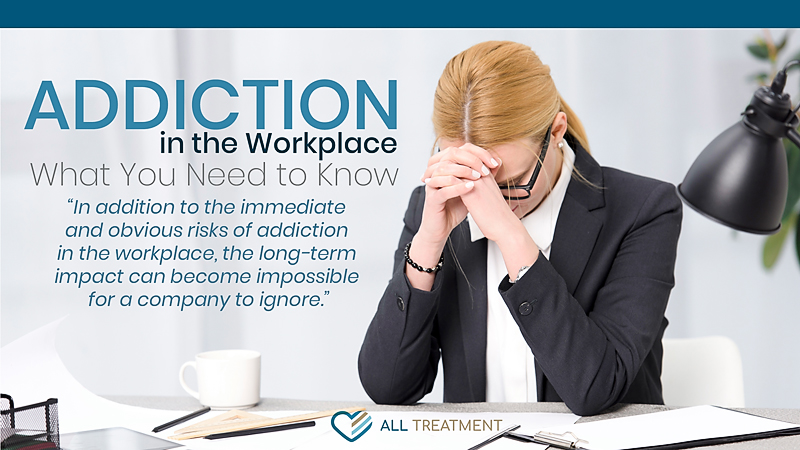Addiction in the Workplace – What You Need to Know

May 20th, 2019
If you’re one of the millions of Americans who goes to work every day, you have a direct stake in the physical and mental health of the colleagues and personnel on whom you depend to do your job. You want to know that your colleague, your boss or your subordinate is not only taking care of themselves but that they aren’t doing anything to jeopardize the safety or progress of your fellow staff. While this expectation has always remained an unspoken reality of the American labor force, the recent alarming escalation of addiction in the workplace has called its feasibility and realism into question.
Data from the Pew Research Center indicates that over 150 million Americans (roughly half the country) are part of the country’s workforce, and many of them are either bringing substance abuse into the workplace or work directly with someone who is. The Substance Abuse and Mental Health Services Administration’s (SAMHSA) National Survey on Drug Use and Health indicate that one in 13 American suffers from alcohol use disorder. The agency also reports that nearly 11 million American workers suffer from some kind of drug or alcohol use disorder. Addiction in the workplace significantly jeopardizes organization health, individual safety, and employee morale, all of which we can easily derail a company for good.
Financial and Human Impact of Addiction in the Workplace
In addition to the immediate and obvious risks of addiction in the workplace, the long-term impact can become impossible for a company to ignore. Data from the National Council on Alcoholism and Drug Dependence indicates that 35 percent of patients with an occupational injury were at-risk drinkers; 16 percent of emergency room patients injured at work tested positive for alcohol and 11 percent of workplace fatality victims had been drinking at the time of the accident. The agency also reports that 70 percent of Americans who use illegal drugs are employed and that problem-drinkers are 270 percent more likely to have an accident.
At the same time, the National Safety Council reports:
- An estimated $74 billion is lost every year in reduced work productivity due to alcohol consumption, stemming from absences, reduced output, premature retirement or death, or reduced earning potential.
- Employees with an alcohol use disorder miss on average 34 percent more days than other workers and are more likely to experience a workplace injury.
- Employees with alcohol use disorders have 16 percent more work turnover every year than other employees.
- Addiction in the workplace leads to on-the-job death, injury and trauma that can significantly increase organizational liability.
Industries With the Highest Rates of Workplace Substance Abuse
While addiction in the workplace is a broad problem across the American labor force, there are some industries where this behavior is far more prevalent than others.
According to data from the National Drug-Free Workplace Alliance, industries with the highest rates of workplace substance use disorder are:
- Construction and Labor – (14 percent)
- Mining (12 Percent)
- Finance and Insurance (Nine percent)
- Information (10 percent)
- Accommodations and Food Service (17 percent)
- Manufacturing (Nine percent)
- Arts, Entertainment and Recreation (13 percent)
Tenure in each of these industries and others come with a unique set of job-related circumstances and working conditions for which many employees may feel the need to self-medicate with illicit substances.
The Role of Employers in Addressing Addiction in the Workplace
In recent years with the increased escalation of addiction in the workplace, employers have started to realize that they are uniquely empowered to guide their employees toward treatment while preserving the harmony and integrity of their organization and keeping the rest of their staff safe and happy. Many are partnering with addiction treatment facilities to offer what is called Employee Assistance Programs (EAPs) to help reduce the cost of treatment and ensure job security for their afflicted staff member.
One of the ways to immediately help curtail addiction in the workplace is to have a clearly defined set of policies and guidelines that are firm yet fair and compassionate. This will signal to your employees who may be battling substance use that you’re committed to their sobriety, recovery, lasting wellness and position at your company.
Is Addiction in the Workplace Affecting Your Place of Business?
Small to medium-sized businesses are the most common workplace incubators for workplace addiction; however, these organizations are also far less likely to offer any kind of treatment resources or EAP programs for their struggling employees. Prolonged and unaddressed addiction in the workplace can create an irreparable fissure in employee morale, workplace productivity and the integrity of an organization. Hiring managers must strike a balance between swift and decisive action and intuitive compassion to help embattled employees find their way to recovery and a second chance. As addiction becomes more and more of an issue at large, it was only a matter of time before it came to work with us.
Resources:

